沃尔玛血汗工厂涉及的商业道德层面分析
管理案例:以沃尔玛为例,看优秀企业的人性化管理
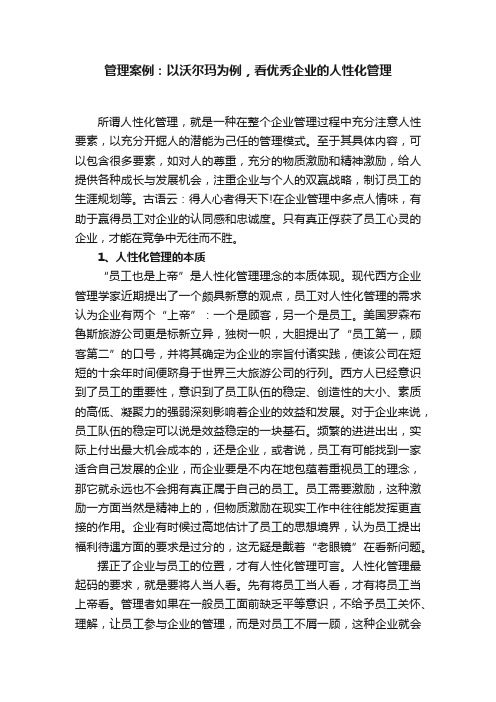
管理案例:以沃尔玛为例,看优秀企业的人性化管理所谓人性化管理,就是一种在整个企业管理过程中充分注意人性要素,以充分开掘人的潜能为己任的管理模式。
至于其具体内容,可以包含很多要素,如对人的尊重,充分的物质激励和精神激励,给人提供各种成长与发展机会,注重企业与个人的双赢战略,制订员工的生涯规划等。
古语云:得人心者得天下!在企业管理中多点人情味,有助于赢得员工对企业的认同感和忠诚度。
只有真正俘获了员工心灵的企业,才能在竞争中无往而不胜。
1、人性化管理的本质“员工也是上帝”是人性化管理理念的本质体现。
现代西方企业管理学家近期提出了一个颇具新意的观点,员工对人性化管理的需求认为企业有两个“上帝”:一个是顾客,另一个是员工。
美国罗森布鲁斯旅游公司更是标新立异,独树一帜,大胆提出了“员工第一,顾客第二”的口号,并将其确定为企业的宗旨付诸实践,使该公司在短短的十余年时间便跻身于世界三大旅游公司的行列。
西方人已经意识到了员工的重要性,意识到了员工队伍的稳定、创造性的大小、素质的高低、凝聚力的强弱深刻影响着企业的效益和发展。
对于企业来说,员工队伍的稳定可以说是效益稳定的一块基石。
频繁的进进出出,实际上付出最大机会成本的,还是企业,或者说,员工有可能找到一家适合自己发展的企业,而企业要是不内在地包蕴着重视员工的理念,那它就永远也不会拥有真正属于自己的员工。
员工需要激励,这种激励一方面当然是精神上的,但物质激励在现实工作中往往能发挥更直接的作用。
企业有时候过高地估计了员工的思想境界,认为员工提出福利待遇方面的要求是过分的,这无疑是戴着“老眼镜”在看新问题。
摆正了企业与员工的位置,才有人性化管理可言。
人性化管理最起码的要求,就是要将人当人看。
先有将员工当人看,才有将员工当上帝看。
管理者如果在一般员工面前缺乏平等意识,不给予员工关怀、理解,让员工参与企业的管理,而是对员工不屑一顾,这种企业就会缺乏凝聚力,缺少形成合力的基础。
沃尔玛企业认知报告
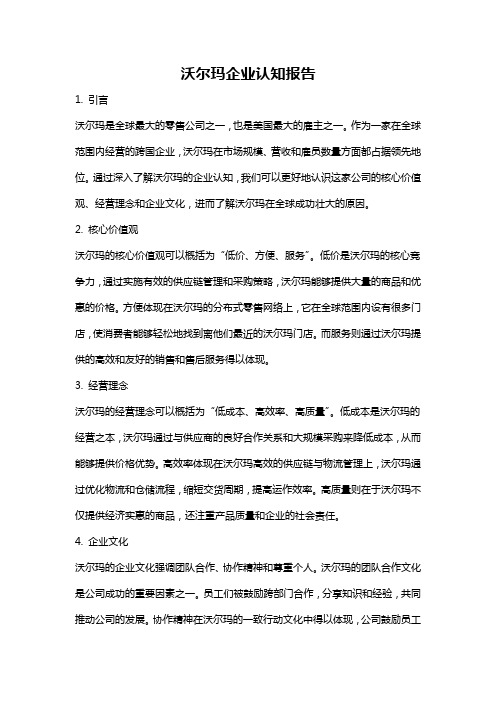
沃尔玛企业认知报告1. 引言沃尔玛是全球最大的零售公司之一,也是美国最大的雇主之一。
作为一家在全球范围内经营的跨国企业,沃尔玛在市场规模、营收和雇员数量方面都占据领先地位。
通过深入了解沃尔玛的企业认知,我们可以更好地认识这家公司的核心价值观、经营理念和企业文化,进而了解沃尔玛在全球成功壮大的原因。
2. 核心价值观沃尔玛的核心价值观可以概括为“低价、方便、服务”。
低价是沃尔玛的核心竞争力,通过实施有效的供应链管理和采购策略,沃尔玛能够提供大量的商品和优惠的价格。
方便体现在沃尔玛的分布式零售网络上,它在全球范围内设有很多门店,使消费者能够轻松地找到离他们最近的沃尔玛门店。
而服务则通过沃尔玛提供的高效和友好的销售和售后服务得以体现。
3. 经营理念沃尔玛的经营理念可以概括为“低成本、高效率、高质量”。
低成本是沃尔玛的经营之本,沃尔玛通过与供应商的良好合作关系和大规模采购来降低成本,从而能够提供价格优势。
高效率体现在沃尔玛高效的供应链与物流管理上,沃尔玛通过优化物流和仓储流程,缩短交货周期,提高运作效率。
高质量则在于沃尔玛不仅提供经济实惠的商品,还注重产品质量和企业的社会责任。
4. 企业文化沃尔玛的企业文化强调团队合作、协作精神和尊重个人。
沃尔玛的团队合作文化是公司成功的重要因素之一。
员工们被鼓励跨部门合作,分享知识和经验,共同推动公司的发展。
协作精神在沃尔玛的一致行动文化中得以体现,公司鼓励员工积极参与企业社会责任项目和慈善事业,通过共同努力为社区做出贡献。
尊重个人是沃尔玛对待员工的态度,公司重视员工的幸福感和工作满意度,提供良好的培训和晋升机会,使员工有机会发挥他们的潜力。
5. 全球化战略沃尔玛在全球范围内实施了成功的全球化战略。
通过不断对市场进行调研,了解消费者需求,沃尔玛能够适应不同国家的市场环境。
同时,沃尔玛注重本地化经营,根据各国市场的特点提供定制化的产品和服务。
此外,沃尔玛不断推动企业数字化和创新,通过引入新技术、优化业务流程和提升数据分析能力,提升效率和顾客满意度。
企业道德案例
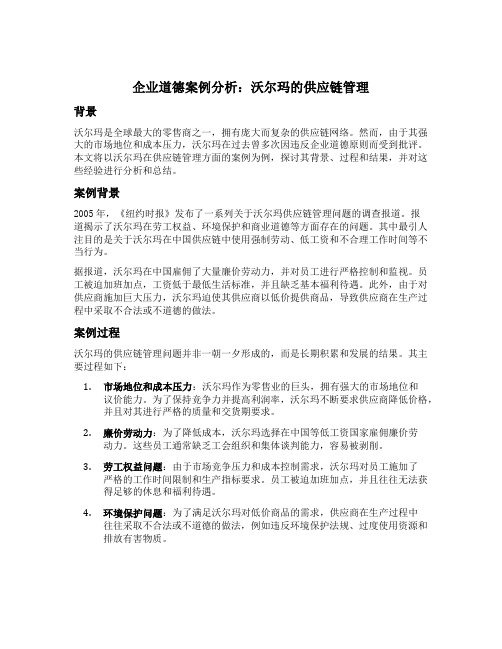
企业道德案例分析:沃尔玛的供应链管理背景沃尔玛是全球最大的零售商之一,拥有庞大而复杂的供应链网络。
然而,由于其强大的市场地位和成本压力,沃尔玛在过去曾多次因违反企业道德原则而受到批评。
本文将以沃尔玛在供应链管理方面的案例为例,探讨其背景、过程和结果,并对这些经验进行分析和总结。
案例背景2005年,《纽约时报》发布了一系列关于沃尔玛供应链管理问题的调查报道。
报道揭示了沃尔玛在劳工权益、环境保护和商业道德等方面存在的问题。
其中最引人注目的是关于沃尔玛在中国供应链中使用强制劳动、低工资和不合理工作时间等不当行为。
据报道,沃尔玛在中国雇佣了大量廉价劳动力,并对员工进行严格控制和监视。
员工被迫加班加点,工资低于最低生活标准,并且缺乏基本福利待遇。
此外,由于对供应商施加巨大压力,沃尔玛迫使其供应商以低价提供商品,导致供应商在生产过程中采取不合法或不道德的做法。
案例过程沃尔玛的供应链管理问题并非一朝一夕形成的,而是长期积累和发展的结果。
其主要过程如下:1.市场地位和成本压力:沃尔玛作为零售业的巨头,拥有强大的市场地位和议价能力。
为了保持竞争力并提高利润率,沃尔玛不断要求供应商降低价格,并且对其进行严格的质量和交货期要求。
2.廉价劳动力:为了降低成本,沃尔玛选择在中国等低工资国家雇佣廉价劳动力。
这些员工通常缺乏工会组织和集体谈判能力,容易被剥削。
3.劳工权益问题:由于市场竞争压力和成本控制需求,沃尔玛对员工施加了严格的工作时间限制和生产指标要求。
员工被迫加班加点,并且往往无法获得足够的休息和福利待遇。
4.环境保护问题:为了满足沃尔玛对低价商品的需求,供应商在生产过程中往往采取不合法或不道德的做法,例如违反环境保护法规、过度使用资源和排放有害物质。
案例结果沃尔玛供应链管理问题的曝光引发了广泛的社会关注和舆论压力。
面对批评和指责,沃尔玛采取了一系列措施来改善其供应链管理,并恢复其声誉。
1.制定供应商行为准则:沃尔玛制定了《全球供应商行为准则》,要求供应商遵守劳工权益、环境保护和商业道德等方面的标准。
商业伦理学案例

商业伦理学案例商业伦理学是研究商业领域中的道德和价值观的学科。
在商业活动中,道德和价值观的问题经常会出现,这些问题通常涉及到商业伦理学中的一些核心问题,例如:诚信、公正、责任、尊重和公共利益等。
本文将讨论几个商业伦理学案例,探讨其中的道德和价值观问题。
案例一:沃尔玛的劳工问题沃尔玛是全球最大的零售商之一,它在全球拥有超过11000家商店和超过220万名员工。
然而,沃尔玛在劳工问题方面一直备受争议。
许多人指责沃尔玛剥削员工,给他们低工资和糟糕的工作条件。
此外,沃尔玛还被指责在国外的工厂中使用童工和违反环保法规。
这个案例涉及到商业伦理学中的多个核心问题,包括公正、责任和尊重。
沃尔玛被指责在对待员工方面缺乏公正,不给他们公正的工资和工作条件。
此外,沃尔玛还被指责在国外的工厂中缺乏社会责任感,违反环保法规和使用童工。
这个案例还涉及到商业伦理学中的另一个核心问题,即企业的社会责任。
企业应该对社会和环境承担责任,而不仅仅是为了赚钱而存在。
沃尔玛在这方面的做法引起了广泛的争议,因为它似乎更关注利润而不是社会责任。
案例二:谷歌的隐私问题谷歌是全球最大的搜索引擎之一,每天处理数十亿个搜索请求。
然而,谷歌在隐私问题方面也备受争议。
谷歌被指责收集用户的个人信息,包括搜索历史、电子邮件和地理位置等。
此外,谷歌还被指责在中国的业务中与政府合作,帮助监视用户的网络活动。
这个案例涉及到商业伦理学中的多个核心问题,包括诚信、公正和责任。
谷歌被指责缺乏诚信,因为它没有充分告知用户它收集了什么信息。
此外,谷歌还被指责缺乏公正,因为它在中国的业务中与政府合作,帮助监视用户的网络活动。
最后,谷歌还被指责缺乏责任,因为它没有保护用户的隐私。
这个案例还涉及到商业伦理学中的另一个核心问题,即企业的社会责任。
企业应该对社会和环境承担责任,而不仅仅是为了赚钱而存在。
谷歌在这方面的做法引起了广泛的争议,因为它似乎更关注利润而不是社会责任。
案例三:可口可乐的环境问题可口可乐是全球最大的软饮料制造商之一,每天销售数百万瓶饮料。
工商管理沃尔玛企业文化-文档资料

3,每天追求卓越
沃尔玛连锁店和山姆会员商店的员工共同实现使顾
客满意的承诺。在每天营业前,员工会聚集在一起 高呼沃尔玛口号,查看前一天的销售情况,讨论当 天的目标。“日落原则”要求员工有一种急切意识, 对当天提出的问题必须在当天予以答复。不断超越、 追求卓越是每个员工的动力所在。
WAL★ MART ® 沃 尔 玛
在各个商店里,沃尔玛公布该店的利润、进货、销售 和减价情况,并且不只是向经理及其助理们公布,而是向 商店的每个员工、计时工和兼职雇员公布各种信息。显然, 部分信息也会流传到公司外面。但他们相信与员工分享信 息的好处远大于信息泄露给外人可能带来的副作用。实际 上到目前为止,这样做并没有对沃尔玛构成损害。 在每年的年会上,员工可直接会见总裁,讨论从工作 条件到发展方向的任何问题。实际上,由于无论是山姆还 是各级主管和区域经理,每周都有三四天在各分店视察, 员工们有很多机会发表自己的见解。据一位观察者说:山 姆认真倾听员工们的话,不仅是商店经理和办公室人员, 甚至看门人也告诉他一切进行得怎样。这样,沃尔玛的员 工每一个人都感到自己是公司的主人,影响着公司的进程。 而领导层也能够更广泛地获得有关公司发展的意见。尽管 公司在不断地扩大,沃尔玛仍极力保持内部管理层与员工 之间的经济交流,努力让每个人感到自己是沃尔玛不断扩 大的家庭中的一员。 幻灯片 8
WAL★ MART ® 沃 尔 玛
服务顾客
保证满意 天天平价 日落原则
• 社区服务
超出顾客期望
WAL★ MART ® 沃 尔 玛
EDLP - Every Day Low Price (Cont'd)
天天平价
WAL★ MART ® 沃 尔 玛
walmart我们主要从四个方面来解读沃尔玛的企业文化一核心价值观二坚持以人为本三创造轻松氛围四真诚回报社会walmart核心价值观顾客就是上帝尊重每一位员工每天追求卓越为了给消费者提供物美价廉的商品沃尔玛不仅通过连锁经营的组织形式高新技术的管理手段努力降低经营费用让利于消费者而且从各个方面千方百计节约开支
全球商业伦理六大案例
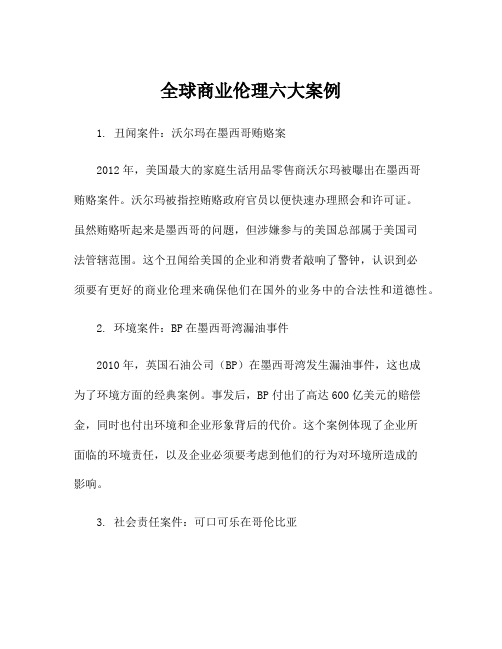
全球商业伦理六大案例1. 丑闻案件:沃尔玛在墨西哥贿赂案2012年,美国最大的家庭生活用品零售商沃尔玛被曝出在墨西哥贿赂案件。
沃尔玛被指控贿赂政府官员以便快速办理照会和许可证。
虽然贿赂听起来是墨西哥的问题,但涉嫌参与的美国总部属于美国司法管辖范围。
这个丑闻给美国的企业和消费者敲响了警钟,认识到必须要有更好的商业伦理来确保他们在国外的业务中的合法性和道德性。
2. 环境案件:BP在墨西哥湾漏油事件2010年,英国石油公司(BP)在墨西哥湾发生漏油事件,这也成为了环境方面的经典案例。
事发后,BP付出了高达600亿美元的赔偿金,同时也付出环境和企业形象背后的代价。
这个案例体现了企业所面临的环境责任,以及企业必须要考虑到他们的行为对环境所造成的影响。
3. 社会责任案件:可口可乐在哥伦比亚可口可乐可能是全球最著名的品牌之一,但公司最近被指控在哥伦比亚违反了社会责任。
在哥伦比亚,可口可乐被指控因与当地的反对者发生争执而联系错误处理。
根据相关报道,这可能会导致地方居民生命威胁。
在这个案例中,可口可乐公司在处理社会责任问题时,没有充分考虑到当地社区的需求和利益,这种行为在商业伦理上是不符合道德标准的。
4. 劳工关系案件:苹果公司在中国苹果公司是全球最有价值的品牌之一,但他们最近也被指责在中国劳工关系方面存在严重问题。
有报道称,苹果工厂中的工人在劳动时间过长,而且违反了最低工资标准。
同时,还有报告建议,苹果应该加强对其供应商的劳工管理,以确保其劳动力的合法性和道德性。
5. 国际贸易案件:荷兰皇家壳牌公司在尼日利亚荷兰皇家壳牌公司涉嫌在尼日利亚某油田地区的环境破坏问题。
壳牌公司被指称在该地区存在过度倾倒废水和排放过度废气的情况,这种行为不仅引起了当地民众的抗议,也导致了生态系统不断恶化。
在这个案例中,荷兰皇家壳牌公司被指责没有考虑到其行为对当地环境的影响,并没有采取合适的措施来降低他们的环境影响。
6. 知识产权案件:高通公司与苹果公司的技术专利战高通公司与苹果公司的专利战可能是当前知识产权争议的一个经典案例。
从企业文化组成要素分析沃尔玛成功之道
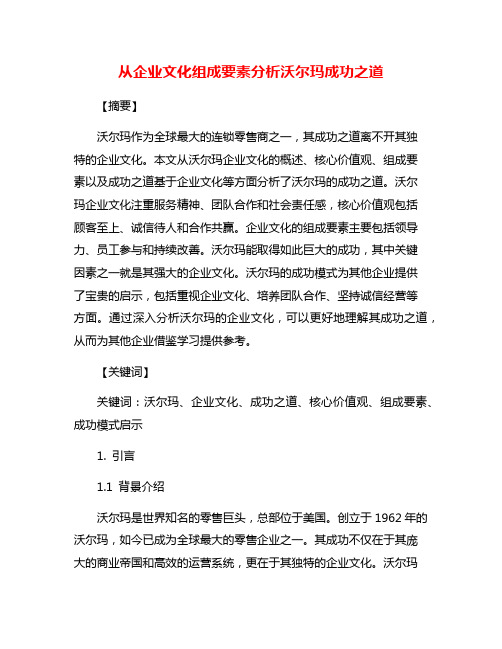
从企业文化组成要素分析沃尔玛成功之道【摘要】沃尔玛作为全球最大的连锁零售商之一,其成功之道离不开其独特的企业文化。
本文从沃尔玛企业文化的概述、核心价值观、组成要素以及成功之道基于企业文化等方面分析了沃尔玛的成功之道。
沃尔玛企业文化注重服务精神、团队合作和社会责任感,核心价值观包括顾客至上、诚信待人和合作共赢。
企业文化的组成要素主要包括领导力、员工参与和持续改善。
沃尔玛能取得如此巨大的成功,其中关键因素之一就是其强大的企业文化。
沃尔玛的成功模式为其他企业提供了宝贵的启示,包括重视企业文化、培养团队合作、坚持诚信经营等方面。
通过深入分析沃尔玛的企业文化,可以更好地理解其成功之道,从而为其他企业借鉴学习提供参考。
【关键词】关键词:沃尔玛、企业文化、成功之道、核心价值观、组成要素、成功模式启示1. 引言1.1 背景介绍沃尔玛是世界知名的零售巨头,总部位于美国。
创立于1962年的沃尔玛,如今已成为全球最大的零售企业之一。
其成功不仅在于其庞大的商业帝国和高效的运营系统,更在于其独特的企业文化。
沃尔玛一直将企业文化视为公司发展的核心驱动力,倡导“顾客至上、员工第一”的价值观。
企业文化成为了沃尔玛的灵魂,引领着公司蓬勃发展并取得成功。
沃尔玛的企业文化秉承着创始人山姆·沃尔顿的理念,强调团队合作、诚信、务实和创新。
这种独特的企业文化不仅塑造了沃尔玛独特的商业模式和企业形象,也成为了沃尔玛成功之道的关键要素。
通过深入分析沃尔玛的企业文化组成要素,我们可以更好地理解沃尔玛的成功之道,从而汲取灵感,为自己的企业发展提供借鉴和启示。
2. 正文2.1 沃尔玛企业文化概述沃尔玛是全球最大的零售企业之一,其企业文化一直被业界称赞为成功之道的关键因素之一。
沃尔玛的企业文化以简单、朴实和务实为核心,秉承着“低价、高效、高质”的经营理念,始终将顾客利益放在第一位。
沃尔玛始终坚持“顾客至上”的宗旨,不断追求服务质量的提升,努力让顾客感受到更优质的购物体验。
世界五百强企业之沃尔玛(从人力资源角度分析沃尔玛的组织结构、薪酬福利以及激励制度)

世界五百强企业之沃尔玛简介一、沃尔玛公司的发展历程1962年美国沃尔玛公司创立于美国西部的一个小镇,1991成为美国第一大零售企业,2001年以后连续名列世界5∞强第一的位置,2002年销售额达到2465亿美元。
沃尔玛公司有折扣商店、仓储商店、购物广场和邻里商店四种零售业态,店铺4694个,员工人数约100万人,分布在全球十余个国家。
1960年代1962年山姆·沃尔顿创建公司,在阿肯色州罗杰斯城开办第一家沃尔玛百货商店1969年 10月31日成立沃尔玛百货有限公司1970年代1970年在阿肯色州的本顿维尔镇成立了公司总部和第一家配送中心1972年沃尔玛公司股票获准在纽约证券交易所上市1975年山姆·沃尔顿受韩国工人的启发,引进了著名的“沃尔玛欢呼”1980年代1983年在俄克拉荷马州的中西部市开设了第一家山姆会员商店1984年山姆·沃尔顿实践对员工的许诺,公司税前利润达到8%,他在华尔街跳起了草裙舞1984年大卫·格拉斯出任公司总裁1987年沃尔玛的卫星网络完成,是美国最大的私有卫星系统。
1988年大卫·格拉斯出任公司首席执行官1988年首家沃尔玛购物广场在密苏里州的华盛顿开业1990年代1990年沃尔玛成为美国第一大零售商1991年沃尔玛商店在墨西哥城开业,沃尔玛开始进入海外市场1992年 3月17日山姆·沃尔顿先生获得由美国总统乔治·布什颁发的自由勋章1992年 4月5日山姆·沃尔顿先生辞世1992年 4月7日S·罗伯森·沃尔顿出任公司董事会主席1992年沃尔玛进入波多黎各1993年沃尔玛国际部成立,波比·马丁出任国际部总裁兼首席执行官1993年 12月首次单周销售额达到10亿美元1994年在加拿大收购了122家Woolco商店1995年进入阿根廷和巴西1996年通过成立合资公司进入中国1997年成为美国第一大私人雇主1997年在美国拥有68万名员工,在美国本土以外有11.5万名员工1997年沃尔玛公司股票成为道琼斯工业平均指数股票1997年沃尔玛年销售额首次突破千亿美元,达到1,050亿美元1998年收购21家Wertkauf,进入德国1998年首次引入社区店,在阿肯色开了三家社区店1998年年度慈善捐款超过1亿美元,达1.02亿美元1998年通过成立合资公司,进入韩国1999年员工总数达到114万人,成为全球最大的私有雇主1999年收购了ASDA集团公司(有229家店),进入英国2000年代2000年在《财富》杂志的“全球最受尊敬的公司”中排名第52000年李斯阁出任沃尔玛公司总裁兼首席执行官2001年在《财富》杂志“全美最受尊敬的公司”中排名第32001年单日销售创历史纪录,在感恩节次日达到12.5亿美元二、沃尔玛的商品沃尔玛的商品涵盖了家居用品、家电、蔬菜瓜果、冷藏日配、五谷杂粮、粮油、化妆品、服饰、文具等大大小小,林林种种不同类型的商品。
企业社会责任——以沃尔玛案例分析

2. 沃尔玛是如何被消费者认可的?
3.沃尔玛对社会的责任是为了增加他们的自身 利益么?
1.在开展社区、环保活动时,合作伙伴的选择 也有限。出于效率和专业的考虑,沃尔玛一般 选择同其他非盈利机构、民间组织合作。而中 国的民问组织起步晚,由于受到当前法律法规 不健全的影响,数量和规模有限,普遍专业程 度低,这使得沃尔玛在挑选合作伙伴时没有太 多的选择,或者面临一个同“非法组织”合作 的困境,在客观上阻碍了公司从事社会责任活 动的热情。
二.案例分析
▪ “我们不要向生活索取什么,而应该向我们所生
活的社区作出贡献,同时传播好的事物。”这是山姆·沃 尔顿的妻子海伦·沃尔顿提出来的倡导。作为零售行业 的领导者,沃尔玛积极将社会责任融入到公司的各项 业务中。“尊重个人、服务顾客、追求卓越”是沃尔 玛企业文化的核心理念,这一理念为沃尔玛积极贯彻 落实企业社会责任计划提供了坚实的基础。
三.基本结论
积极承担企业的社会责任,是沃尔玛取得成 功的主要原因之一。鉴于企业的性质及特点,沃 尔玛的企业社会责任体系主要包括三个方面,即 社区、雇员和环境。针对每一个方面,沃尔玛都 制定了详细的责任范围,以保证企业责任的切实 落实。同时,沃尔玛在承担每一项社会责任的同 时,还注重将社会责任理念传播给责任对象,也 因此,沃尔玛的商业声誉不断地得到提升,集团 的不断扩张成为一种必然的趋势。
自1996年进入中国市场以来,沃尔玛始 终坚持优秀企业公民的标准,在中国的企业 社会责任的计划重点体现在保护环境、回馈 社区、关爱儿童、支持教育和救助灾区等五 方面。
在环境保护方面:
沃尔玛积极参与各项环保公益项目,范围 涵盖绿色能源利用、环保节能、噪音控制、植 树造林等各个领域。100%使用再生能源、实 现零浪费、出售对环境和自然资源无害的产品 是沃尔玛在环保方面的目标;
沃尔玛公司的SWOT分析.doc
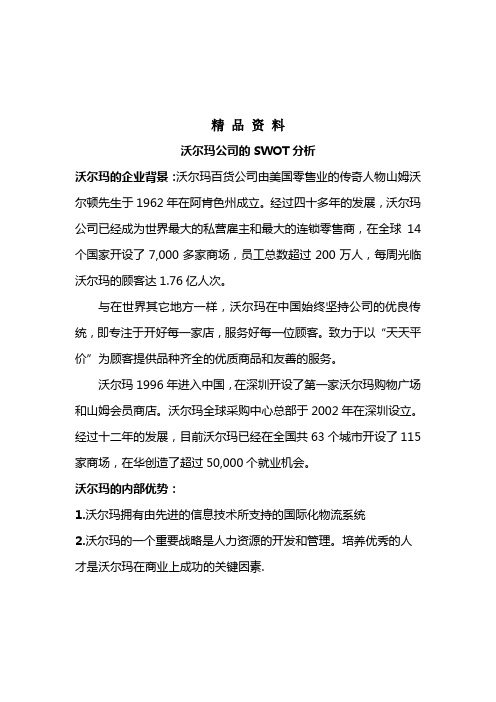
精品资料沃尔玛公司的SWOT分析沃尔玛的企业背景:沃尔玛百货公司由美国零售业的传奇人物山姆沃尔顿先生于1962年在阿肯色州成立。
经过四十多年的发展,沃尔玛公司已经成为世界最大的私营雇主和最大的连锁零售商,在全球14个国家开设了7,000多家商场,员工总数超过200万人,每周光临沃尔玛的顾客达1.76亿人次。
与在世界其它地方一样,沃尔玛在中国始终坚持公司的优良传统,即专注于开好每一家店,服务好每一位顾客。
致力于以“天天平价”为顾客提供品种齐全的优质商品和友善的服务。
沃尔玛1996年进入中国,在深圳开设了第一家沃尔玛购物广场和山姆会员商店。
沃尔玛全球采购中心总部于2002年在深圳设立。
经过十二年的发展,目前沃尔玛已经在全国共63个城市开设了115家商场,在华创造了超过50,000个就业机会。
沃尔玛的内部优势:1.沃尔玛拥有由先进的信息技术所支持的国际化物流系统2.沃尔玛的一个重要战略是人力资源的开发和管理。
培养优秀的人才是沃尔玛在商业上成功的关键因素.3.管理高度规范化,经营理念科学化。
沃尔玛所有管理均通过信息技术来完成,所有的工作人员都是按照计算机的指令工作,绝不会随意行事。
4.营运促销具有特色。
沃尔玛的卖场布置非常活性化,在商品演示、限时促销、和商场的娱乐性促销活动等方面都具有独特之处5.美国品牌商品价格优势明显。
这一点不表现在价格签上,而体现在其所取得的采购回扣上。
6.沃尔玛是著名的零售业品牌,头上戴着世界第一的光环,而且物美价廉、货物繁多。
沃尔玛的内部劣势1.沃尔玛建立了世界上最大的食品零售帝国。
尽管它在信息技术上拥有优势,但因为其经营规模不断扩大,导致对某些领域的控制力不够强。
2.因为沃尔玛的商品种类繁多,涵盖了服装、食品等多个部门,可能在较集中的某一领域与竞争对手相比没有优势。
3.该公司是全球化范围不够广,目前只开拓了少数几个国家的市场。
4.国内工资福利待遇不公正的情况很普遍。
集团内部分歧较严重。
浅谈沃尔玛的企业文化建设

浅谈沃尔玛的企业文化建设引言企业文化是指一种独特的、在整个组织内共享的、能够影响组织成员行为的价值观、信念、态度以及行为准则。
沃尔玛是世界上最大的零售公司之一,其成功能够归功于其独特而强大的企业文化。
本文将从沃尔玛的企业文化价值观、组织结构和行为准则等方面进行探讨,并分析其对企业发展的影响。
一、沃尔玛的企业文化价值观沃尔玛的企业文化价值观体现在其三项核心价值观:尊重个体、服务客户、追求卓越。
尊重个体意味着沃尔玛始终关注和尊重每个员工的权益和需求,鼓励员工发挥自己的创造力和潜能。
通过营造积极的工作环境和提供发展机会,沃尔玛激励员工积极进取,为公司的成功做出贡献。
服务客户是沃尔玛的核心使命,公司始终努力为客户提供优质的服务和产品,确保客户满意度的提升。
追求卓越是沃尔玛对自己设定的高标准和追求完美的态度,公司鼓励员工在工作中不断追求创新、提升工作质量,并持续改进和超越。
二、沃尔玛的组织结构沃尔玛的组织结构是其企业文化建设的重要组成部分。
沃尔玛拥有分布在全球多个国家和地区的分支机构,其组织结构具有明确的层级和责任划分。
沃尔玛以店长为核心,形成了一套高度灵活的组织管理模式。
店长在实施公司战略、管理员工和实现业绩目标方面发挥着重要作用。
沃尔玛倡导分权和去中心化管理,使得每个门店都能够迅速适应本地市场需求并作出决策。
这种组织结构和管理方式有助于激发员工的主动性和创造力,并提高沃尔玛的经营效率和竞争力。
三、沃尔玛的行为准则沃尔玛坚持以诚信为基础的行为准则,公司将道德和道德价值置于高度重视的位置。
沃尔玛的行为准则包括了对员工、客户、供应商和合作伙伴的责任和要求。
对于员工而言,沃尔玛要求员工遵守道德规范,保持职业操守,诚实守信,并且禁止任何形式的腐败行为。
对于客户,沃尔玛致力于提供优质产品和服务,确保真实标价和公正待遇。
对于供应商和合作伙伴,沃尔玛秉持公平竞争的原则,建立良好的合作关系,共同实现长期发展。
通过严格遵守行为准则,沃尔玛塑造了正直和公正的企业形象,树立了良好的企业信誉。
浅析沃尔玛百货有限公司诚信经营理念
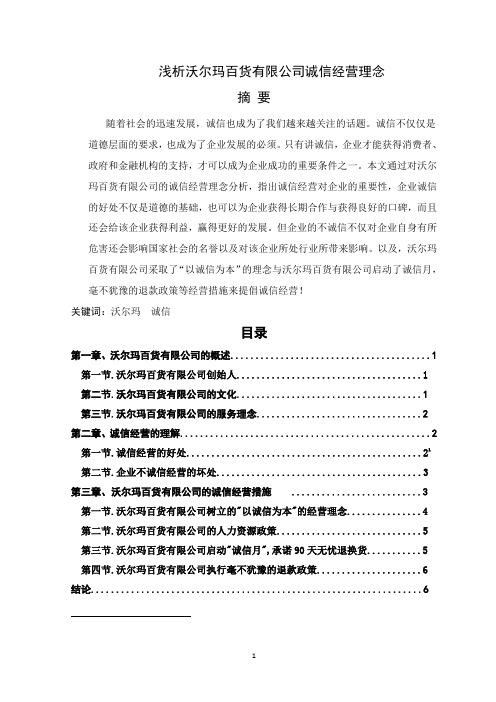
浅析沃尔玛百货有限公司诚信经营理念摘要随着社会的迅速发展,诚信也成为了我们越来越关注的话题。
诚信不仅仅是道德层面的要求,也成为了企业发展的必须。
只有讲诚信,企业才能获得消费者、政府和金融机构的支持,才可以成为企业成功的重要条件之一。
本文通过对沃尔玛百货有限公司的诚信经营理念分析,指出诚信经营对企业的重要性,企业诚信的好处不仅是道德的基础,也可以为企业获得长期合作与获得良好的口碑,而且还会给该企业获得利益,赢得更好的发展。
但企业的不诚信不仅对企业自身有所危害还会影响国家社会的名誉以及对该企业所处行业所带来影响。
以及,沃尔玛百货有限公司采取了“以诚信为本”的理念与沃尔玛百货有限公司启动了诚信月,毫不犹豫的退款政策等经营措施来提倡诚信经营!关键词:沃尔玛诚信目录第一章、沃尔玛百货有限公司的概述 (1)第一节.沃尔玛百货有限公司创始人 (1)第二节.沃尔玛百货有限公司的文化 (1)第三节.沃尔玛百货有限公司的服务理念 (2)第二章、诚信经营的理解 (2)第一节.诚信经营的好处 (21)第二节.企业不诚信经营的坏处 (3)第三章、沃尔玛百货有限公司的诚信经营措施 (3)第一节.沃尔玛百货有限公司树立的"以诚信为本"的经营理念 (4)第二节.沃尔玛百货有限公司的人力资源政策 (5)第三节.沃尔玛百货有限公司启动"诚信月",承诺90天无忧退换货 (5)第四节.沃尔玛百货有限公司执行毫不犹豫的退款政策 (6)结论 (6)致谢 (6)参考文献 (7)第一章、沃尔玛百货有限公司的概述第一节.沃尔玛百货有限公司创始人山姆·沃尔顿,生于1918年,美国人。
山姆于1962年创建了沃尔玛百货有限公司,到1990年已经超过了行业的排头兵—西尔斯和凯马特,成为了世界上最大的零售商。
沃尔玛百货有限公司是世界上成长最快最成功的公司之一。
山姆·沃尔顿很小就认为,小孩应当帮家里赚钱,对家里做出贡献。
沃尔玛经营行为与消费者行为与心理分析
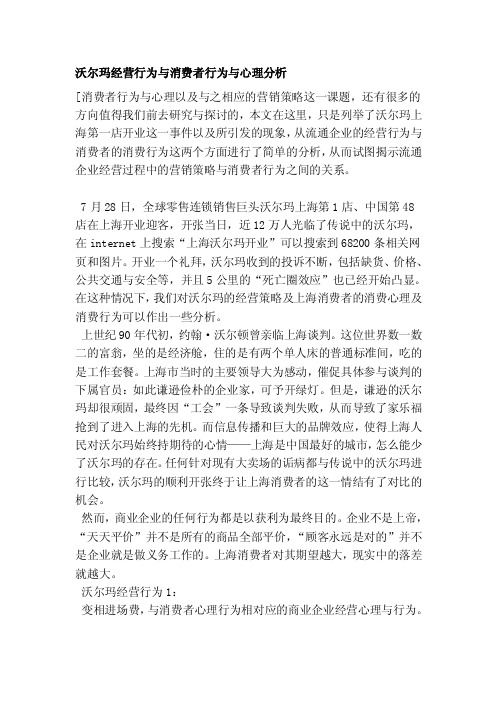
沃尔玛经营行为与消费者行为与心理分析[消费者行为与心理以及与之相应的营销策略这一课题,还有很多的方向值得我们前去研究与探讨的,本文在这里,只是列举了沃尔玛上海第一店开业这一事件以及所引发的现象,从流通企业的经营行为与消费者的消费行为这两个方面进行了简单的分析,从而试图揭示流通企业经营过程中的营销策略与消费者行为之间的关系。
7月28日,全球零售连锁销售巨头沃尔玛上海第1店、中国第48店在上海开业迎客,开张当日,近12万人光临了传说中的沃尔玛,在internet上搜索“上海沃尔玛开业”可以搜索到68200条相关网页和图片。
开业一个礼拜,沃尔玛收到的投诉不断,包括缺货、价格、公共交通与安全等,并且5公里的“死亡圈效应”也已经开始凸显。
在这种情况下,我们对沃尔玛的经营策略及上海消费者的消费心理及消费行为可以作出一些分析。
上世纪90年代初,约翰·沃尔顿曾亲临上海谈判。
这位世界数一数二的富翁,坐的是经济舱,住的是有两个单人床的普通标准间,吃的是工作套餐。
上海市当时的主要领导大为感动,催促具体参与谈判的下属官员:如此谦逊俭朴的企业家,可予开绿灯。
但是,谦逊的沃尔玛却很顽固,最终因“工会”一条导致谈判失败,从而导致了家乐福抢到了进入上海的先机。
而信息传播和巨大的品牌效应,使得上海人民对沃尔玛始终持期待的心情——上海是中国最好的城市,怎么能少了沃尔玛的存在。
任何针对现有大卖场的诟病都与传说中的沃尔玛进行比较,沃尔玛的顺利开张终于让上海消费者的这一情结有了对比的机会。
然而,商业企业的任何行为都是以获利为最终目的。
企业不是上帝,“天天平价”并不是所有的商品全部平价,“顾客永远是对的”并不是企业就是做义务工作的。
上海消费者对其期望越大,现实中的落差就越大。
沃尔玛经营行为1:变相进场费,与消费者心理行为相对应的商业企业经营心理与行为。
像沃尔玛这样的大卖场入驻沪上,本应该是各大供应商的必争销售渠道,但是有些企业却表示放弃。
国外企业伦理案例
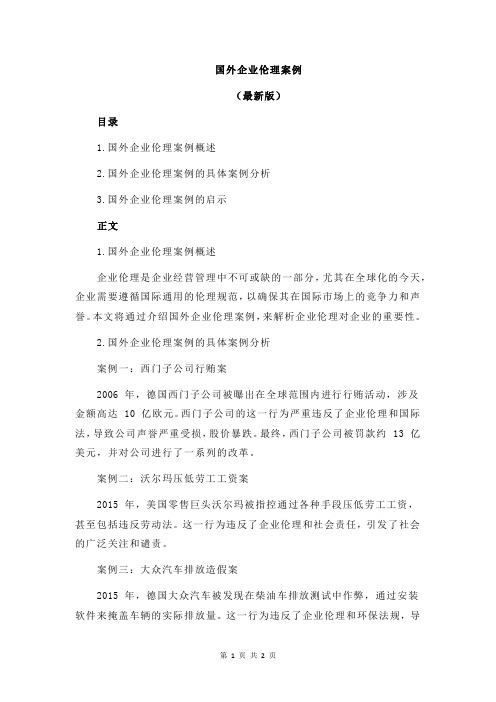
国外企业伦理案例
(最新版)
目录
1.国外企业伦理案例概述
2.国外企业伦理案例的具体案例分析
3.国外企业伦理案例的启示
正文
1.国外企业伦理案例概述
企业伦理是企业经营管理中不可或缺的一部分,尤其在全球化的今天,企业需要遵循国际通用的伦理规范,以确保其在国际市场上的竞争力和声誉。
本文将通过介绍国外企业伦理案例,来解析企业伦理对企业的重要性。
2.国外企业伦理案例的具体案例分析
案例一:西门子公司行贿案
2006 年,德国西门子公司被曝出在全球范围内进行行贿活动,涉及
金额高达 10 亿欧元。
西门子公司的这一行为严重违反了企业伦理和国际法,导致公司声誉严重受损,股价暴跌。
最终,西门子公司被罚款约 13 亿美元,并对公司进行了一系列的改革。
案例二:沃尔玛压低劳工工资案
2015 年,美国零售巨头沃尔玛被指控通过各种手段压低劳工工资,
甚至包括违反劳动法。
这一行为违反了企业伦理和社会责任,引发了社会的广泛关注和谴责。
案例三:大众汽车排放造假案
2015 年,德国大众汽车被发现在柴油车排放测试中作弊,通过安装
软件来掩盖车辆的实际排放量。
这一行为违反了企业伦理和环保法规,导
致公司股价暴跌,并面临巨额罚款。
3.国外企业伦理案例的启示
从以上案例可以看出,企业伦理对企业的重要性不言而喻。
企业必须遵循诚实、公正、透明、负责等基本原则,以确保其在市场竞争中的优势和声誉。
同时,企业还应积极履行社会责任,推动社会和谐发展。
沃尔玛的调查报告
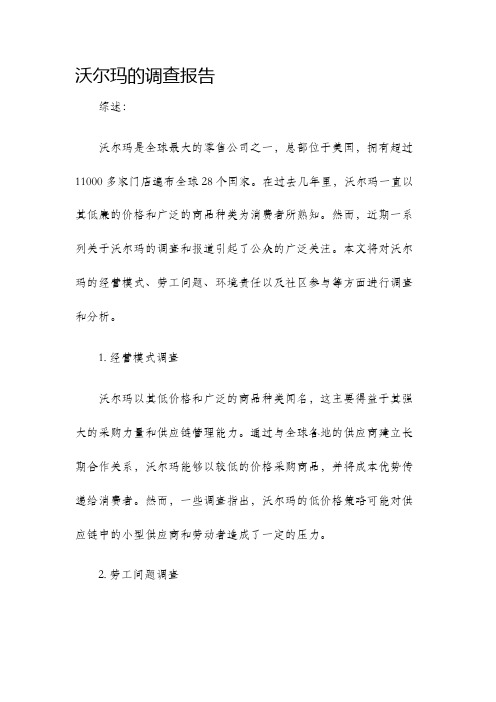
沃尔玛的调查报告综述:沃尔玛是全球最大的零售公司之一,总部位于美国,拥有超过11000多家门店遍布全球28个国家。
在过去几年里,沃尔玛一直以其低廉的价格和广泛的商品种类为消费者所熟知。
然而,近期一系列关于沃尔玛的调查和报道引起了公众的广泛关注。
本文将对沃尔玛的经营模式、劳工问题、环境责任以及社区参与等方面进行调查和分析。
1. 经营模式调查沃尔玛以其低价格和广泛的商品种类闻名,这主要得益于其强大的采购力量和供应链管理能力。
通过与全球各地的供应商建立长期合作关系,沃尔玛能够以较低的价格采购商品,并将成本优势传递给消费者。
然而,一些调查指出,沃尔玛的低价格策略可能对供应链中的小型供应商和劳动者造成了一定的压力。
2. 劳工问题调查沃尔玛是全球雇佣员工最多的零售企业之一,但关于其员工福利和工作条件的报道一直备受争议。
一些调查和报道指出,沃尔玛存在员工工资待遇不公、过度工时、缺乏福利等问题。
此外,也有报道称沃尔玛对员工的工会组织活动持消极态度。
这些问题使得沃尔玛成为劳工权益保护组织和社会运动的目标之一。
3. 环境责任调查作为全球最大的零售企业之一,沃尔玛在环境责任方面承担着重要的角色。
公司一直致力于推动可持续发展,减少对环境的影响。
沃尔玛采取了一系列措施来降低能源消耗、减少废物和碳排放量,并鼓励供应商采取环保措施。
然而,一些调查和报道指出,沃尔玛在环境责任方面还存在一定的挑战,例如,有报道称沃尔玛在处理废物和化学品问题上做得不够完善。
4. 社区参与调查沃尔玛作为全球零售业巨头,在社区参与方面承担着重要责任和角色。
公司通过各种途径向社区回馈,并参与社会公益项目。
然而,一些调查和报道指出,沃尔玛的社区参与并不总是得到公众的广泛认可。
有报道称,沃尔玛在一些社区中的扩张计划可能破坏了当地的小型零售商,并对当地社区环境产生一定影响。
结论:综合以上调查和报道,沃尔玛作为全球最大的零售公司,其经营模式和价格策略给消费者带来了实实在在的好处。
沃尔玛(中国)的企业社会责任分析从观念到行动的审视
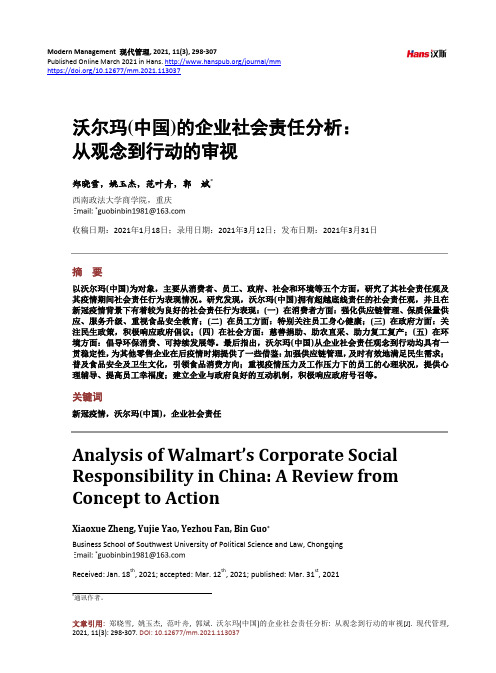
Modern Management 现代管理, 2021, 11(3), 298-307Published Online March 2021 in Hans. /journal/mmhttps:///10.12677/mm.2021.113037沃尔玛(中国)的企业社会责任分析:从观念到行动的审视郑晓雪,姚玉杰,范叶舟,郭斌*西南政法大学商学院,重庆收稿日期:2021年1月18日;录用日期:2021年3月12日;发布日期:2021年3月31日摘要以沃尔玛(中国)为对象,主要从消费者、员工、政府、社会和环境等五个方面,研究了其社会责任观及其疫情期间社会责任行为表现情况。
研究发现,沃尔玛(中国)拥有超越底线责任的社会责任观,并且在新冠疫情背景下有着较为良好的社会责任行为表现:(一) 在消费者方面:强化供应链管理、保质保量供应、服务升级、重视食品安全教育;(二) 在员工方面:特别关注员工身心健康;(三) 在政府方面:关注民生政策,积极响应政府倡议;(四) 在社会方面:慈善捐助、助农直采、助力复工复产;(五) 在环境方面:倡导环保消费、可持续发展等。
最后指出,沃尔玛(中国)从企业社会责任观念到行动均具有一贯稳定性,为其他零售企业在后疫情时期提供了一些借鉴:加强供应链管理,及时有效地满足民生需求;普及食品安全及卫生文化,引领食品消费方向;重视疫情压力及工作压力下的员工的心理状况,提供心理辅导、提高员工幸福度;建立企业与政府良好的互动机制,积极响应政府号召等。
关键词新冠疫情,沃尔玛(中国),企业社会责任Analysis of Walmart’s Corporate SocialResponsibility in China: A Review fromConcept to ActionXiaoxue Zheng, Yujie Yao, Yezhou Fan, Bin Guo*Business School of Southwest University of Political Science and Law, ChongqingReceived: Jan. 18th, 2021; accepted: Mar. 12th, 2021; published: Mar. 31st, 2021*通讯作者。
沃尔玛血汗工厂涉及的商业道德层面分析
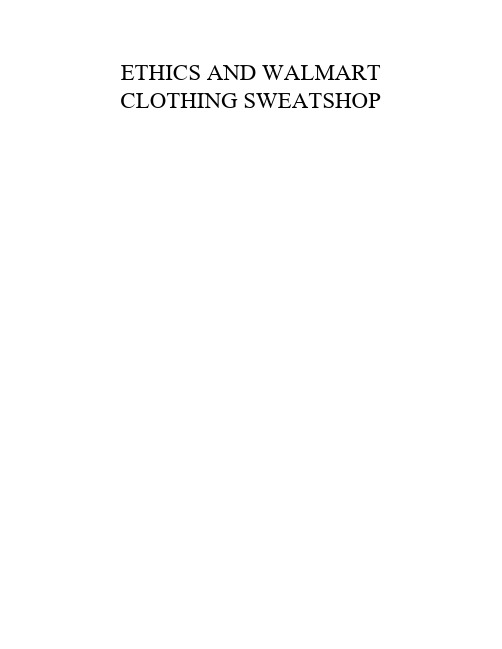
ETHICS AND WALMART CLOTHING SWEATSHOPIntroductionWith the development of economy, many large number of multinational companies establish their sweatshop in developing countries resulting in many unhuman consequences. Take Walmart as an example, the Rona building collapse killed 1130 workers with low salary and long working hours. This essay outlines the whole accident occurred and demonstrate literature review from human rights, political role of companies and sustainable supply chain aspects. Finally, recommendations of various stakeholders can be seen to improve the ethical condition in multinational corporations business environment, which is the main purpose of the essay. That is, cheap labors are able to get their access to their legal and basic ethical human rights while working for clothing industry and other areas.BackgroundCase: Walmart and Rana plaza collapse in Bangladesh1.General introduction of Walmart.Walmart stores, as an US biggest retailor company in the world, aims to provide goods at low prices to its customers. Due to minimizing the cost of manufacturing, supplies of Walmart are located mostly in developing countries with cheap labors (The Economist,2013)2.E mployee’s working condition in Bangladesh.Salaries of workers are highly low in Bangladesh. Month wages of clothing employees range fron 70 to 100 dollars which is just one fifth of workers’ salaries in China and many children as works in the damp little dark room doing embroidery or dyeing.3.The Rona plaza collapse.At 24,April 2013 , an 8-story commercial building named Rona plaza which is located several miles away from Bangladesh capital collapsed with death of 1130 garment workers for Walmart clothing industry and 2500 injured(Huffington Post,2014). It is noticed later that cracks of the building was found and all the staff of plaza was evaluated immediately including employees of a bank and shops. However, garment works was ordered to go back to keep working by the building owner ignoring the danger of cracks with a threat of losing salary of one month the second day when the deadliest garment-factory accident happened.Besides, brands like Nike, H&M, Gap, Victoria’s Secret, Disney, Sears, Joe Fresh as well as Liz Claibourne are all reported to own their textile sweatshops like Walmart mainly in south-east Asia and southern and central part of the US during recent years.Literature reviewHuman rights.Corporations of global influence develop economy worldwide in a great deal. However, it can be seen clearly that many social challenges occur due to corporations such as human right violations and environment pollution. modern society, corporations are expected and required to address these issues through following government laws and regulations and social ethical morals to ensure labors with safe working conditions, fair wage and ethical treatment). Specifically, literature theories include social contract theory, social justice theory, stakeholder theory, deontological theory and market theory by professional researchers (Wilson,2005).Social contract theory.Wilson(2005) states that corporations agree to enter a contract with various stakeholders to exchange natural resources products with ethical mutual benefit. However, in fact, irreversible natural pollution, unhuman sweatshops, wildlife extinction and so forth are obvious proof of the break of previous aggrement. Walmart employed children labor breaking local labor laws, providing unsafe working conditions like a Rana building with crackers and paying less wage.Social justice theory.Social justice theory offer protection for the weaker stakeholders such as workers in sweatshops in developing countries who is highly possible to be treated as slaves by their bosses to in actual markets to create efficiency gains.Theory of rights.Theory of rights reflects multinational corporations today does have rights such as property rights. Friedman (1970) also states that business aims to maximize its profitslegally. However, the theory states that reasonable rights of stakeholders like customers and employees are not supposed to be undermined or sacrificed by such rights or be deprived by owners to gain profit (Wilson, 2005). Owners of business should not be as an instrumental stakeholder theorist. In the scenario, Walmart sacrifices safety of almost 3000 working employees to satisfy owners’ economic profit with utilitarianism managerial mindset.Deontological theory.The major point of deontological theory is that managers of corporations are morally obligated to treat its employees equally and provide welfare such as safety protections and transportation convenience to satisfy various needs which is the content of normative stakeholder theory. Specifically, clothing workings evaluated from plaza because of crackers have a say to refuse to go back to work instead of being at risk of losing wages(Lozano and Pandi,2005).Market theory.From the economic point of view, actual markets motivate buyers and sellers to operate together with a result of lowering costs (Scalet 2014). The history of commerce is a history of remarkable innovations to lower transaction costs.A market wage is still a good choice than unemployment (Friedrich Hayek,1978). Walmart as an American company is one part in capitalism market in which government have less power to control compared with communism such as China. Government of Bangladesh have less power of economy market control which could not protect workers of its own country. Meanwhile, even the pay could not cover normal living expenses, it is still the best choice of the poor and unemployment.1.Political role of corporationsIt can be concluded that there is no agreed meaning for corporations’ political responsibilities (Fooks et al, 2013). To be more specific, Walmart as a multinational company has grown into an extremely powerful corporation based on its sheer size and wealth which result in amplifying its influence in ethier political area or social sphere. In contract, power of government seems to be diminished and non-government organization becomes more active at the same time. However, corporate social responsibility to various stakeholders has increasingly become a heated issue in nowadays (Garriga and Melle,2004). Research on corporations’ political power postulates a narrow normative theory, in contract with the other string of theories which are more descriptive in nature .2.Sustainable supply chainAs we all know, companies operate in a highly competitive market environment where cost reduction in supply chain operations is the key basement of gaining large profit espescially compared with commercial brands (Carbone et al,2012). Therefore, developing countries with weak legal framework and cheaper labor is an appropriate option.From doing research ethical theories on supply chain clearly focus on issues such as environmental pollution and sustainability which pay less attention to social benefits (Friedman.1970).Recommendations1 Bangladesh government practicesBase on the social justice theory, all government policy should aim to build a sustainable legal framework. It is discovered that some illegal sweatshops of clothing industry are ignored by government officers. Besides, government should establish newpolitical strategy to gain more power to involving the market operation to let it better off in certain circumstances. Furthermore, Bangladesh should build social welfare for poor and unemployed people to give them a choice to not to be servant of certain unethical clothing industry.2 supplier practicesWalmart should invest essential fund to employ qualified safeguards to educate workers with professional training and monitor supplier activities in order to meet both globally accepted standards and local regulations (Huffington Post, 2014). It can also collaborate with the local government to carry out injury benefit project and share risks with all business owners. Moreover, Bangladesh’s solution is an example to other developing as it will alert all developing countries about what might happened in global business (Cruz, 2013).3 Cooperation among stakeholdersGovernment, multinational companies such as Walmart, non-government organizations and other potential stakeholders can work together to tackle Bangladesh’s clothing industry. Non-government organizations should quit their autonomy and operate with profit-making companies to be powerful enough in order to enact laws and monitoring each other. Stakeholder theory focus mainly on addressing problems of the ethics of capitalism and managerial mindset. (Houngbo, 2014)).ConclusionTo conclude, based on the sweatshop of Walmart and the Rona building collapse accident, findings extracted from literature includes human rights, corporations’ political role and sustainable supply chain. To prevent the phenomenon occurring second time,several recommended behaviors of supply chain, government, non-government organizations and multinational corporations should cooperate and monitor all together to boost business in an ethical sustainable way.ReferenceHayek, F. A. (1978). The atavism of social justice. New studies in philosophy, politics, economics and the history of ideas, 5768.Friedman, A. (1970). Foundations of modern analysis. Courier Corporation.Fooks, G., Gilmore, A., Collin, J., Holden, C., & Lee, K. (2013). The limits of corporate social responsibility: techniques of neutralization, stakeholder management and political CSR.Journal of Business Ethics, 112(2), 283-299.Garriga, E., & Melé, D. (2004). Corporate social responsibility theories: Mapping the territory.Journal of business ethics, 53(1-2), 51-71.Portillo Carrasco, H. (2005). Guillermo Lozano Bautista. Revista Colombiana de Cardiología, 11(7), 317-318.Post, H. (2014). Robert Buckingham, University of Saskatchewan Dean, Fired.(2014). Huffington Post.Scalet, S. (2014). Efficiency and Well-Being. In S. Scalet (Ed.), Markets, Ethics, and Business Ethics (pp. 96–114). United States of America: Pearson.Unit, E. I. (2012). Competing across borders: How cultural and communication barriers affect business. The Economist.Wilson, D. E., & Reeder, D. M. (Eds.). (2005). Mammal species of the world: a taxonomic and geographic reference (Vol. 1). JHU Press.Joshi, R. K., Carbone, P., Wang, F. C., Kravets, V. G., Su, Y., Grigorieva, I. V., ... & Nair, R. R.(2014). Precise and ultrafast molecular sieving through graphene oxide membranes.Science, 343(6172), 752-754.Houngbo, G. (2014). Key challenges for labour rights protection on a global scale. In Conference on Fostering Labour Rights in the Global Economy 20-21 February 2014.。
国外企业伦理案例

国外企业伦理案例【实用版】目录1.引言2.国外企业伦理案例概述3.国外企业伦理案例分析4.国外企业伦理案例启示5.结论正文【引言】在经济全球化的大背景下,企业之间的竞争愈发激烈,而企业伦理的实践对于塑造良好的企业形象、提升竞争力具有重要意义。
本文将通过分析国外企业伦理案例,探讨企业如何在经营活动中遵循伦理道德,提升企业形象,增强竞争力。
【国外企业伦理案例概述】国外企业伦理案例主要涉及以下几个方面:企业社会责任、诚信经营、公平竞争、环境保护、尊重劳动者权益等。
以下将以具体案例为例,进行详细分析。
【国外企业伦理案例分析】1.企业社会责任:以沃尔玛为例,作为全球最大的零售企业,沃尔玛积极履行企业社会责任,通过推动可持续发展、支持社区建设等方式,为社会做出贡献。
2.诚信经营:以安然公司为例,该公司因财务造假、欺诈等不诚信行为,最终导致公司破产。
这一案例表明诚信经营对企业的重要性。
3.公平竞争:以微软公司为例,曾因垄断行为被欧盟委员会指控,最终微软公司调整经营策略,遵守公平竞争原则。
4.环境保护:以 bp 公司为例,2010 年,bp 公司在墨西哥湾发生重大油污事故,公司积极承担责任,加大环保投入,改进生产工艺。
5.尊重劳动者权益:以耐克公司为例,曾因忽视供应商的劳动条件问题,被指责侵犯劳动者权益。
后来,耐克公司加强对供应商的管理,保障劳动者权益。
【国外企业伦理案例启示】1.强化企业伦理意识,提升企业形象。
2.诚信经营,树立良好的企业信誉。
3.积极履行社会责任,促进企业可持续发展。
4.遵守公平竞争原则,维护市场秩序。
5.重视环境保护,实现绿色发展。
6.尊重劳动者权益,营造和谐劳动关系。
【结论】总之,企业伦理对于企业的经营和发展具有重要意义。
通过分析国外企业伦理案例,我们可以发现,遵循伦理道德、积极履行社会责任、诚信经营、尊重劳动者权益等,是企业在激烈竞争中立于不败之地的关键。
- 1、下载文档前请自行甄别文档内容的完整性,平台不提供额外的编辑、内容补充、找答案等附加服务。
- 2、"仅部分预览"的文档,不可在线预览部分如存在完整性等问题,可反馈申请退款(可完整预览的文档不适用该条件!)。
- 3、如文档侵犯您的权益,请联系客服反馈,我们会尽快为您处理(人工客服工作时间:9:00-18:30)。
ETHICS AND WALMART CLOTHING SWEATSHOPIntroductionWith the development of economy, many large number of multinational companies establish their sweatshop in developing countries resulting in many unhuman consequences. Take Walmart as an example, the Rona building collapse killed 1130 workers with low salary and long working hours. This essay outlines the whole accident occurred and demonstrate literature review from human rights, political role of companies and sustainable supply chain aspects. Finally, recommendations of various stakeholders can be seen to improve the ethical condition in multinational corporations business environment, which is the main purpose of the essay. That is, cheap labors are able to get their access to their legal and basic ethical human rights while working for clothing industry and other areas.BackgroundCase: Walmart and Rana plaza collapse in Bangladesh1.General introduction of Walmart.Walmart stores, as an US biggest retailor company in the world, aims to provide goods at low prices to its customers. Due to minimizing the cost of manufacturing, supplies of Walmart are located mostly in developing countries with cheap labors (The Economist,2013)2.E mployee’s working condition in Bangladesh.Salaries of workers are highly low in Bangladesh. Month wages of clothing employees range fron 70 to 100 dollars which is just one fifth of workers’ salaries in China and many children as works in the damp little dark room doing embroidery or dyeing.3.The Rona plaza collapse.At 24,April 2013 , an 8-story commercial building named Rona plaza which is located several miles away from Bangladesh capital collapsed with death of 1130 garment workers for Walmart clothing industry and 2500 injured(Huffington Post,2014). It is noticed later that cracks of the building was found and all the staff of plaza was evaluated immediately including employees of a bank and shops. However, garment works was ordered to go back to keep working by the building owner ignoring the danger of cracks with a threat of losing salary of one month the second day when the deadliest garment-factory accident happened.Besides, brands like Nike, H&M, Gap, Victoria’s Secret, Disney, Sears, Joe Fresh as well as Liz Claibourne are all reported to own their textile sweatshops like Walmart mainly in south-east Asia and southern and central part of the US during recent years.Literature reviewHuman rights.Corporations of global influence develop economy worldwide in a great deal. However, it can be seen clearly that many social challenges occur due to corporations such as human right violations and environment pollution. modern society, corporations are expected and required to address these issues through following government laws and regulations and social ethical morals to ensure labors with safe working conditions, fair wage and ethical treatment). Specifically, literature theories include social contract theory, social justice theory, stakeholder theory, deontological theory and market theory by professional researchers (Wilson,2005).Social contract theory.Wilson(2005) states that corporations agree to enter a contract with various stakeholders to exchange natural resources products with ethical mutual benefit. However, in fact, irreversible natural pollution, unhuman sweatshops, wildlife extinction and so forth are obvious proof of the break of previous aggrement. Walmart employed children labor breaking local labor laws, providing unsafe working conditions like a Rana building with crackers and paying less wage.Social justice theory.Social justice theory offer protection for the weaker stakeholders such as workers in sweatshops in developing countries who is highly possible to be treated as slaves by their bosses to in actual markets to create efficiency gains.Theory of rights.Theory of rights reflects multinational corporations today does have rights such as property rights. Friedman (1970) also states that business aims to maximize its profitslegally. However, the theory states that reasonable rights of stakeholders like customers and employees are not supposed to be undermined or sacrificed by such rights or be deprived by owners to gain profit (Wilson, 2005). Owners of business should not be as an instrumental stakeholder theorist. In the scenario, Walmart sacrifices safety of almost 3000 working employees to satisfy owners’ economic profit with utilitarianism managerial mindset.Deontological theory.The major point of deontological theory is that managers of corporations are morally obligated to treat its employees equally and provide welfare such as safety protections and transportation convenience to satisfy various needs which is the content of normative stakeholder theory. Specifically, clothing workings evaluated from plaza because of crackers have a say to refuse to go back to work instead of being at risk of losing wages(Lozano and Pandi,2005).Market theory.From the economic point of view, actual markets motivate buyers and sellers to operate together with a result of lowering costs (Scalet 2014). The history of commerce is a history of remarkable innovations to lower transaction costs.A market wage is still a good choice than unemployment (Friedrich Hayek,1978). Walmart as an American company is one part in capitalism market in which government have less power to control compared with communism such as China. Government of Bangladesh have less power of economy market control which could not protect workers of its own country. Meanwhile, even the pay could not cover normal living expenses, it is still the best choice of the poor and unemployment.1.Political role of corporationsIt can be concluded that there is no agreed meaning for corporations’ political responsibilities (Fooks et al, 2013). To be more specific, Walmart as a multinational company has grown into an extremely powerful corporation based on its sheer size and wealth which result in amplifying its influence in ethier political area or social sphere. In contract, power of government seems to be diminished and non-government organization becomes more active at the same time. However, corporate social responsibility to various stakeholders has increasingly become a heated issue in nowadays (Garriga and Melle,2004). Research on corporations’ political power postulates a narrow normative theory, in contract with the other string of theories which are more descriptive in nature .2.Sustainable supply chainAs we all know, companies operate in a highly competitive market environment where cost reduction in supply chain operations is the key basement of gaining large profit espescially compared with commercial brands (Carbone et al,2012). Therefore, developing countries with weak legal framework and cheaper labor is an appropriate option.From doing research ethical theories on supply chain clearly focus on issues such as environmental pollution and sustainability which pay less attention to social benefits (Friedman.1970).Recommendations1 Bangladesh government practicesBase on the social justice theory, all government policy should aim to build a sustainable legal framework. It is discovered that some illegal sweatshops of clothing industry are ignored by government officers. Besides, government should establish newpolitical strategy to gain more power to involving the market operation to let it better off in certain circumstances. Furthermore, Bangladesh should build social welfare for poor and unemployed people to give them a choice to not to be servant of certain unethical clothing industry.2 supplier practicesWalmart should invest essential fund to employ qualified safeguards to educate workers with professional training and monitor supplier activities in order to meet both globally accepted standards and local regulations (Huffington Post, 2014). It can also collaborate with the local government to carry out injury benefit project and share risks with all business owners. Moreover, Bangladesh’s solution is an example to other developing as it will alert all developing countries about what might happened in global business (Cruz, 2013).3 Cooperation among stakeholdersGovernment, multinational companies such as Walmart, non-government organizations and other potential stakeholders can work together to tackle Bangladesh’s clothing industry. Non-government organizations should quit their autonomy and operate with profit-making companies to be powerful enough in order to enact laws and monitoring each other. Stakeholder theory focus mainly on addressing problems of the ethics of capitalism and managerial mindset. (Houngbo, 2014)).ConclusionTo conclude, based on the sweatshop of Walmart and the Rona building collapse accident, findings extracted from literature includes human rights, corporations’ political role and sustainable supply chain. To prevent the phenomenon occurring second time,several recommended behaviors of supply chain, government, non-government organizations and multinational corporations should cooperate and monitor all together to boost business in an ethical sustainable way.ReferenceHayek, F. A. (1978). The atavism of social justice. New studies in philosophy, politics, economics and the history of ideas, 5768.Friedman, A. (1970). Foundations of modern analysis. Courier Corporation.Fooks, G., Gilmore, A., Collin, J., Holden, C., & Lee, K. (2013). The limits of corporate social responsibility: techniques of neutralization, stakeholder management and political CSR.Journal of Business Ethics, 112(2), 283-299.Garriga, E., & Melé, D. (2004). Corporate social responsibility theories: Mapping the territory.Journal of business ethics, 53(1-2), 51-71.Portillo Carrasco, H. (2005). Guillermo Lozano Bautista. Revista Colombiana de Cardiología, 11(7), 317-318.Post, H. (2014). Robert Buckingham, University of Saskatchewan Dean, Fired.(2014). Huffington Post.Scalet, S. (2014). Efficiency and Well-Being. In S. Scalet (Ed.), Markets, Ethics, and Business Ethics (pp. 96–114). United States of America: Pearson.Unit, E. I. (2012). Competing across borders: How cultural and communication barriers affect business. The Economist.Wilson, D. E., & Reeder, D. M. (Eds.). (2005). Mammal species of the world: a taxonomic and geographic reference (Vol. 1). JHU Press.Joshi, R. K., Carbone, P., Wang, F. C., Kravets, V. G., Su, Y., Grigorieva, I. V., ... & Nair, R. R.(2014). Precise and ultrafast molecular sieving through graphene oxide membranes.Science, 343(6172), 752-754.Houngbo, G. (2014). Key challenges for labour rights protection on a global scale. In Conference on Fostering Labour Rights in the Global Economy 20-21 February 2014.。
